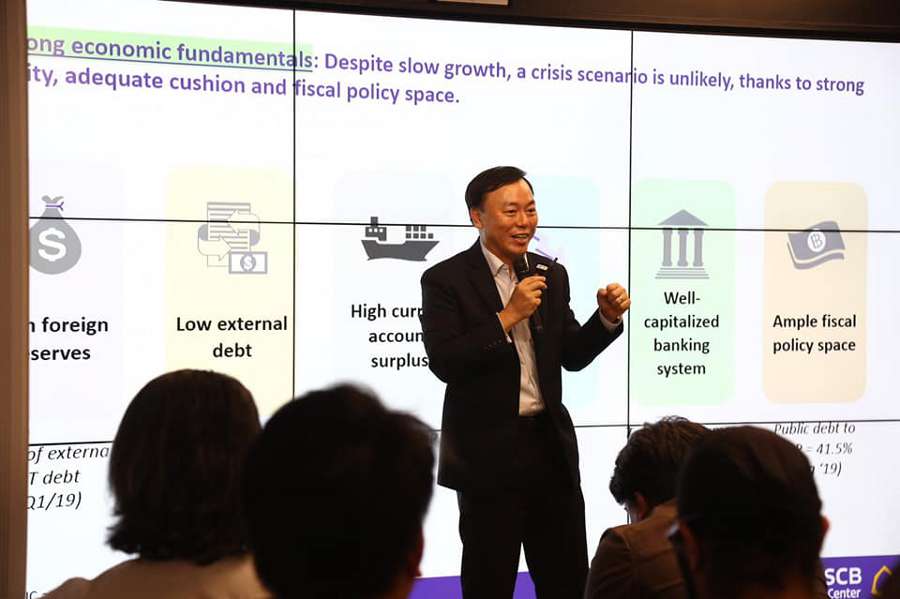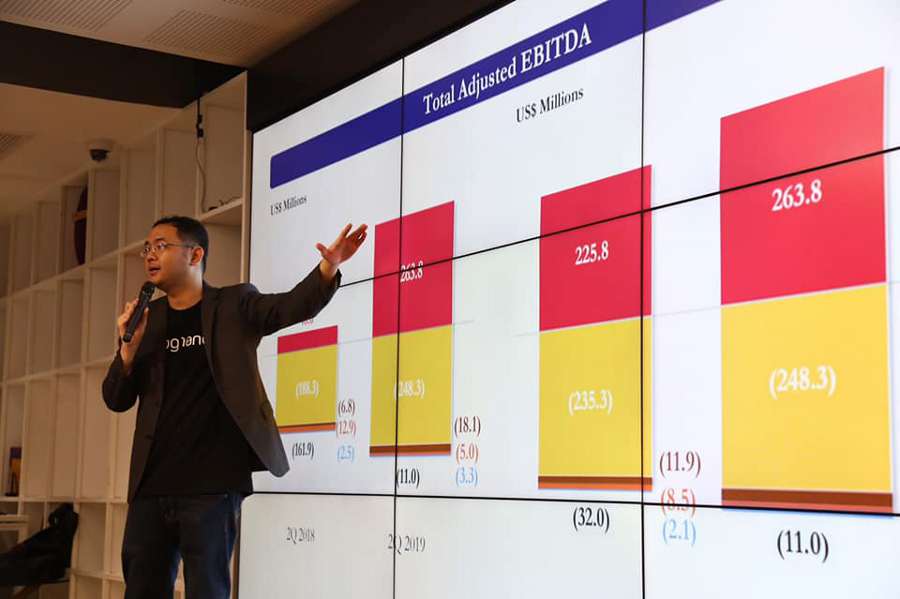I WANT
RELATED LINKS
I WANT
RELATED LINKS
RELATES LINKS
I WANT
RELATES LINKS
Services
Related Links
Use and Management of Cookies
We use cookies and other similar technologies on our website to enhance your browsing experience. For more information, please visit our Cookies Notice.
- Personal Banking
- Stories & Tips
- BUSINESS MAKER
- 3 trends that SMEs must know: Economy – Technology – Consumer
- Personal Banking
- ...
- 3 trends that SMEs must know: Economy – Technology – Consumer
3 trends that SMEs must know: Economy – Technology – Consumer
27-09-2019
COFFEE TALK SERIES EP#1
What will Thai SMEs have to fight in 2020? Join the trend update in order to prepare to fight the intense business with 3 topics that SMEs must know to keep up and know quickly. Both economic with economics expert, Dr. Yunyong Thaicharoen, First Executive Vice President of the Economic Intelligence Centre (EIC). Followed by the intense competition in the technology world with Isariya Paireepairit from BLOGNONE. Culminating with the understanding of Data to dominate the minds of consumers with Khun Phutthasak Tantisutthiwet from WISESIGHT.
The direction of the Thai economy must be aggressive or defensive by Dr. Yunyong Thaicharoen

Internal and external economic factors affecting business operations. Including the setting of competitive strategies which consists of four factors which are global economy, Thai economic slowdown, structural factors and auxiliary factors.
1. Global Economy (Heightened External Pressures)
Global Economy (Heightened External Pressures) The main issue affecting the global economy is the US-China countermeasures, which fight in 3 dimensions: Trade War, import taxes increase resulting in trading in the world market to slow down, Tech War, the competition in technology lead by the US ban, Hauwei, and Currency War that China let the currency depreciate. There are also geopolitical risks such as the BREXIT, North Korea, protests in Hong Kong or the oil field in Saudi Arabia was bombed. All affecting the world exports that plummet and including affecting the confidence of economists around the world. Which many countries tend to negative GDP. However, the overall condition is still not that bad because the service sector in developed countries is still good and employment is still strong. The world economy next year is likely to slow down. Causing central banks in many countries to start using more relaxed monetary policy such as reducing interest rates or even negative interest rates. Including injecting money into the system.
2. Broad-based Domestic Slowdown
The broad-based domestic slowdown in the Thai economy: This year and next year 2020, it is expected that Thai GDP will grow at 3%. The main cause affecting the Thai economy is the Trade War. Which aside from affecting the slowdown of exports also affected industrial production, investment, and employment. And has a result of reduced tourism and tourist spending. In addition, Thai people's spending has decreased until affecting consumer confidence.
Regarding the baht strength against the dollar at 5%. When compared with competitors, it was found that in the past 5 years, the baht was 23% stronger than competitors in the average. In addition, tourism declined to only 4.8% from 10%, mainly due to the decline in Chinese tourists and there are competitors from other countries that Chinese people like, such as Cambodia. In addition, the spending of Chinese tourists is also reduced. Partly due to the Chinese policy that allows tourists to import fewer products into the country but allowing more products to be imported via e-commerce. Businessmen who trade with China must adjust. In addition, the employment conditions in the country are likely to decrease.
Another point is the rising of household debt that higher than other developing countries. The Bank of Thailand issued the LTB measure, forcing home buyers to have a higher down payment. To reduce household debt, but it will have an impact on real estate businesses that have already started to see. Including car sales that started to turn negative. Overall consumer confidence decreased.

3.Structural Challenges
The trend of automation is using machinery to replace more labor. The number of OT workers could be reduced to 6 million. Digitization: the e-commerce business will grow a lot and there will be a concentration of sales with the top 5 large companies, which together make up 88% of all sales. The big companies will have more and more competitive advantages.
4. Supporting Factors
the chance of a serious economic crisis like 1997 is very small. Because of different factors and situations. The economy will slow but will not be severe. Because Thailand still has many good additional factors meaning that the reserves are still large, less foreign debt, export surplus imports a lot, low inflation. The banks are ready to support customers and have strong capital funds, low public debt, reduced interest on loans and a lot of government investment, especially the EEC or "Eastern Economic Corridor Project". Foreign investors come to invest, especially China, who escaped the trade war with the United States. And various government measures to stimulate the economy, such as shopping, shopping, using government benefits cards credit guarantee for SME's TCG, etc.
In summary, from all factors, the business must do both proactive and defensive at the same time. We need to focus on the customer-centric, technology adoption, as well as have good business partners and a partnership Network. From the study, it is found that different products and online sales channels are also more likely to grow. Although the economic downturn is challenging, every field has winners and losers. Winners must be flexible, take good care of finances, have enough working capital. Must adjust the plan quickly, make advance decisions based on the information and take good care of the customers that are important to the business.
Foreign technology the dangers or opportunities of Thai SMEs by Isariya Paireepairit BLOGNONE
Various applications that we are used to Whether social media such as Facebook, Instagram, Twitter, YouTube, all 4 are American apps and LINE which are from Japan. If turning to look at the large e-commerce apps that dominate throughout Thailand, such as Lazada and Shopee, behind the scenes is an e-commerce war to usurp consumers by "burning money". Multi-billion-dollar level Between the two major Chinese companies, Alibaba and Tencent, fought through agents. Of course, this battlefield is very intense. Players who do not have enough money to die and fall as well.

Delivery apps or delivery services that we use regularly to deliver our favorite dishes, whether Grab, GET, LJNE MAN or Foodpanda. There is no player that belongs to Thailand because it belongs to Malaysia, Indonesia, Japan, and Germany respectively. Which makes it difficult for new companies with less capital to compete. Now, Grab is partnering with Central and other companies. Make it possible to raise a large fund. The Delivery apps business is a business called O-2-O or Online to Offline. And of course, these digital business models will yield huge losses at first to beat competitors, buy market share and hope to monopolize the market in the long term to be able to determine the price in the future.
Logistic apps are no different because the big players in the market, whether Kerry, Flash, J&T, Lalamove or SCG, are foreign, whether Kerry is from a big company from Hong Kong or SCG in partnership with Japan. Leaving only the Thai Post that is the owner of true Thai nationality.
All the different types of applications that we have seen will see that the big owners that dominate the market are entirely foreign. There are only Payment apps that Thai companies can still compete. Almost all of these are the payment apps of the bank, whether SCB, Kbank, Krungsri, KTB or BBL, which shows that Thai banks are strong enough to be able to consume external capital flows.

When the situation is like this, where are the chances of Thai people? Because foreign money is huge and in terms of technology, he is far ahead of us. The technology business is a collective market. We don't see anyone able to compete with Google or Facebook. Only number one can survive. Therefore, the competitive opportunities of Thai SMEs are to find gaps and must adjust to get examples of Thai SMEs that see business gaps and can adjust to compete for such as
JIB is Thai e-commerce that can survive in this era. An online computer shop that offers free 24-hour delivery. Deliver products to your hands within 3 hours which the main products are game products that are high value, high growth products. Another example of building material like OneStockHome, e-commerce that finds its niche. By focusing on selling construction materials like B-2-B. And Wongnai, not just restaurant review apps but is also partnering with the lineman. There are also other apps, Restaurant Management System (RMS), for small restaurants to accept orders and send to LINEMAN to help stores take orders more efficiently. All are examples that show that Thai SMEs that can adapt and see the gap to play at the big platform has not come down to make and apply technology to the business well, can still compete and survive.
The world changed, customers changed, fought with Consumer Insight by Phutthasak Tantisutthiwet

5 factors that can make a business decision in the digital age successful are 1. Data 2. Insight 3. Personalized 4. Experience 5. Be real. 4 out of 5 items require all data. But the question is, how can we use data to succeed?
Good products and services must understand and meet customer needs. Must have measurement data. Must have a passion for business and must be able to use the information available for business benefits. PWC says that companies that use data to make well-informed decisions will be able to develop their business 3 times better than other companies. But now 64% of executives still use personal experience and opinions to make decisions
In fact, we are always with data. When there are enough customers, the shop owner or the person in front of the store who meets regular customers should be able to guess what the original customers will order. This is data. It's just data that has been accumulated in terms of an experience only that person can use and make a decision. The good thing about modern data is that it makes the experience tangible that others can understand. Allowing people with only two years of work experience to be able to make decisions like those who work for ten years or at least similarly are important. Therefore, allowing employees to enter their experience into data is very useful.
But consumers in the digital age are complex. The modern consumers sometimes just want to enjoy the social world. In this era, if you think it is normal, you may not be able to catch up with new things on social media. Because consumers today are having fun and have their own personality.
Data will tell us 2 parts: 1. Say what they think 2. Say what they did. For example, if we ask customers who come to eat at the restaurant whether the food is delicious or not, they say it is delicious, but the food is still a lot in the dish. We must take it back to analyze. Therefore, to understand consumers well, both parts must be combined. But most of the digital information is at the top of the iceberg that we see is what they do. For example, using google analytics, we know the behavior of what they are doing. But we don't know what he thinks, like knowing that he likes knowing that he is sharing but does not know why he likes why does he share.
Social Media Research is a combination of information and ideas. By collecting information on social media that is only public information. Social Media Research will divide the method of data collection into the core. The horizontal axis is divided into active (ask) and passive (do not ask). The vertical axis is qualitative data and quantitative data. An active approach is qualitative data, such as asking for a focus group or questionnaire for passive, ie waiting for data to float up, such as sticking to see behaviors such as where people like to sit in How to shop in and out or use observation.

Normally, information from social listening is passive. The meaning goes in and wait and see what people are saying Listening and processing what is the pros and cons. Most of the information obtained is qualitative about what people say. But when working, it will count how many times someone has talked about it to come out as a quantitative number. Therefore, they have mixed data both quality and quantity which helps to understand consumers better. Sometimes what he says himself may be something we don't expect. Which made other interesting issues even more.
What does Social Data say? Examples of eco-cars, if asked by the brand, will think that people want to know about fuel efficiency, car size, beauty, and price. But it turns out that on social media people talk about performance and after-sales service. Because the point is people who will buy Eco cars, they already know that the price must be cheap, must save fuel as a small car. Therefore, when they already knew all this information when talking on social media, would like to know about other things such as this small car can drive to upcountry. Because teenagers who buy cars of this size still have a passion and want to travel. So, it became a talk about performance. And after-sales service is the cost that must be paid after the purchase. If asked are there any brands that speak these two stories? There are some performance issues, but after-sales service, almost no one talks.
Data science may be good at data. But may not understand the business and do not understand the nature of the product. For example, have men do research on lipstick colors that women use May not be as good as women do because men don't understand the product. Data creation is not only good in data but must understand the business as well, must analyze the data of the business character. Data creators must collaborate closely with the business. A business person must give enough information to the data maker. Don't think that they are good at everything.
Information is a map that will take us in the right direction. The decision does not require 100% information. We have no way to know 100% of the information. And importantly, we can't wait.
If we kept waiting, we couldn't catch up. Just have about enough data to try. And at least we do not fall. Just have about 70% of the information and then decide. Trying and learning and then gradually adjust. Ask the right questions and get the right data. Try to reduce judgment and then coordinate with more data people will be able to use data to create magic for their business.
Know quickly and broadly to see opportunities in doing business that meets the needs of the digital age customers. Flexible, adaptable, and have good partners is a survival path for Thai SMEs.
Want to gain more knowledge and update business trends. Meet us at the SCB Business Center, which has good knowledge and many good assistants to help Thai SMEs grow and move forward together.
